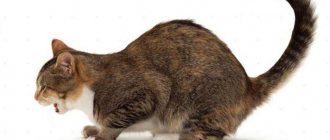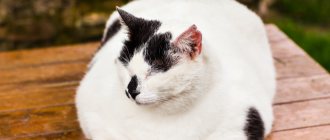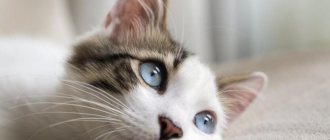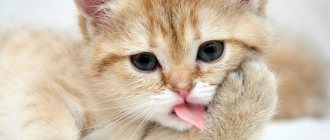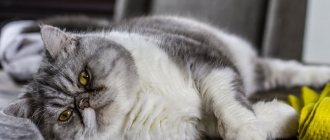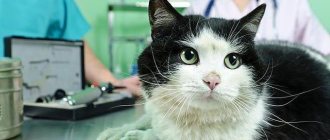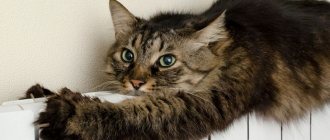Modern owners treat their pets with love and care. Respiratory diseases in mustachioed pets are quite rare. For this reason, if a cat is coughing and wheezing, then such symptoms should not be ignored. The reasons for this condition of the animal can lie not only in a cold, but also in the development of various pathologies. Information about the main factors leading to coughing in cats will help in providing assistance.
Cat cough: causes and types
A sharp release of air from the lungs can be reflexive - a protective reaction to external stimuli, and symptomatic - accompanying some underlying disease. Those. This is not a separate disease, it is always a sign of something more serious.
Reflex cough spasm occurs in the following cases:
- the presence of foreign bodies in the airway or esophagus (the cough will continue until the foreign object is removed or coughed up);
- changes in the inhaled air: caustic gases, smoke, any sharp-smelling substances or fine powders (flour, mustard powder, peppers, etc.).
Symptomatic accompanies:
- respiratory diseases provoked by viruses or bacteria (pneumonia, laryngotracheitis, bronchitis, etc.);
- allergies in the form of bronchial asthma;
- diseases of the heart and vascular system (cardiac or cardiac cough);
- helminthic infestations (parasites that infect the lungs or gastrointestinal tract with their vital activity provoke a cough);
- neck or chest injuries affecting the lungs or trachea, as well as internal injuries and scratches to the throat;
- oncological pathologies of the respiratory system and neoplasms;
- accumulation of fluid or air in the chest cavity;
- diaphragmatic hernia (through which the abdominal organs enter the chest cavity, causing irritation).
Asthma attacks
Bronchial asthma is a chronic disease of the respiratory tract. It is allergic in nature and is not associated with bacterial growth. The nature of development is most often genetic, but sometimes acquired pathologies occur. The signs of the disease are as follows:
- severe coughing attack;
- dyspnea;
- restless state;
- hoarse breathing;
- pronounced cyanosis is visible on the mucous membranes;
- increased drowsiness;
- refusal of food;
- the pet takes a forced position - lowers its head and stretches its neck, trying to cough up phlegm;
- in severe cases, eye rolling and loss of consciousness may occur.
To accurately establish a diagnosis, tests are taken from the animal, a hardware examination of the abdominal and chest cavity is performed, and then treatment is prescribed. It includes taking antispasmodics, antibacterial drugs, as well as vitamin complexes, especially vitamins C and E, which are natural antioxidants. It is also recommended to purchase an inhaler that will help relieve the attack and prevent your pet from suffocating.
Features of cat cough
- very rare;
- difficult to diagnose, because this type of animal tends to suppress it, taking forced positions and changing their usual lifestyle to a sedentary one.
The cough is also different:
According to the strength of the cough impulse:
| By frequency of manifestation:
|
By timbre:
| According to the presence of sputum and its characteristics:
|
By duration:
| By time of appearance:
|
All of the above characteristics are an important factor in making an accurate diagnosis.
Respiratory diseases
A common cold can easily provoke coughing, sneezing, swelling of the mucous membranes, and discharge of pus from the nasal passages and eyes. During this period, it is difficult for the pet to swallow, which is why he stops eating and even drinking. Inflamed airways, fortunately, are easy to treat.
The disease is eliminated with the help of antiviral, antibacterial medications, as well as expectorants or antitussives, which are prescribed depending on the type of cough. To restore and subsequently strengthen the animal’s immunity, the veterinarian prescribes a vitamin complex. As a preventive measure , you should take your cat for vaccination , which will reduce the risk of a serious disease.
Symptoms of the main types of cat cough
Physiologically, a cough in cats looks like this: the pet’s abdominal wall is pulled towards the spine (as if inward), the back bends, the head drops down while the neck is stretched forward (the cat presses to the floor), the mouth opens slightly, and a sound characteristic of a cough is heard. Sometimes it may be accompanied by obvious wheezing or vomiting.
When noticing your cat is coughing, it is important to take a close look at the nature of the cough and accompanying symptoms in order to provide an accurate description of your pet's condition to your veterinarian.
Respiratory cough
Accompanies some viral and microbial infections of the lower respiratory tract and the common cold. During illness, the cat usually coughs and sneezes, discharge from the nose appears, and the general temperature may increase. The cough impulse is initially loud and dry, which over time becomes dull and with purulent sputum.
Cardiac (heart) cough
It arises from the fact that the hypertrophied (highly enlarged) heart or its individual chambers put pressure on the trachea, from where an irritation impulse is sent to the brain, and a cough reflex occurs. The intensity of the cough increases slowly over time as the heart continues to enlarge. The process is similar to that of a cat choking and trying to get rid of something, coughing it up. In this case, there is no sputum, no foreign objects are detected. From day to day the cough does not change its manifestation.
Infestations
Invasive cough is caused by the irritable activity of stomach or lung parasitic worms. Typically, with this pathology, the cat coughs and wheezes. More precisely, outwardly the animal assumes a posture as when coughing, the tongue sticks out, the process begins with hoarse sharp exhalations, then turns into coughing, sometimes with vomiting. What usually comes out is white foam or parasites in the stomach. Usually, at such a moment, owners cannot understand for sure whether the pet is coughing or wheezing, or both. Therefore, when describing a symptom, the phrase “the cat seems to be coughing” is often heard. You may experience weight loss and decreased appetite at the same time.
Trichobezoars
Periodic one-time intense cough spasm, almost always leading to vomiting. The cat is coughing as if she is choking. As a result of such a cough, hairballs are sure to come out through the mouth.
Traumatic cough
Appears after internal or external trauma to the respiratory system - for example, after eating bones (usually fish or chicken) or external trauma after street fights or falls from a height. With internal non-through injuries (or scratches), periodic single coughs are observed, usually observed while eating or drinking. With severe injuries, external restlessness, meowing and refusal to eat may occur after the first attempts to eat. With external injuries, forced (fast and deep) inspiration can be observed at the time of swallowing food and injuries are detected in the neck or chest area.
Bronchial asthma
Sudden attacks accompanied by heavy breathing and wheezing. The animal may cough for a relatively long time without stopping. Often seasonal. It becomes clear that the cat is having difficulty breathing. May be accompanied by sneezing and allergic reactions.
Oncological pathologies
Cough with respiratory cancer, as a rule, begins to appear in the terminal stages (the very last). May be accompanied by pain, hemoptysis, general weakness and depression.
What is a cough
From a physiological point of view, a cough is a noisy, increased exhalation through the mouth, created by contractions of the respiratory muscles and provoked by irritation of the sensitive nerve endings (receptors) of the respiratory tract. In the brain of humans and higher animals there is a so-called cough center, the activation of which sends a signal to the respiratory muscles.
According to medical data, cough is not a specific sign of the disease, and in most cases reflects only symptoms associated with general ill health. This is a reflexive attempt by the body to cleanse itself of foreign particles and exudate accumulated inside (sputum, mucus, blood, pus) in order to restore the patency of the airways.
How can you tell if your cat is not just coughing, but choking?
A cat coughing “as if she was choking” and really choking are radically different concepts. First you need to decide what is meant by the second case. This means that the animal has a foreign object stuck in its throat or esophagus, which cannot pass into the stomach on its own, and is also not removed from the mouth by the animal itself. It is simply impossible to confuse this condition with a regular cough!
When not just a cough, but a cat choking:
- the condition does not appear out of nowhere, it is usually preceded by eating or playing with small objects;
- the animal does not have time to assume a “coughing” pose”
- the cough itself is absent, there are wheezing, “sniffing” and increasing vomiting;
- the cat rubs its muzzle with its paw, as if trying to independently remove something it has choked on (an important clinical symptom);
- the secretion of saliva increases, which begins to flow from the mouth due to the inability to swallow it.
Observing such a picture, you can be absolutely sure that the cat was choking!
There are two options for help:
- open the cat’s mouth and independently remove the foreign object that the animal has choked on, if there is access to it;
- if nothing foreign is visible, but the cat shows signs of choking, you need to urgently go to the veterinary hospital.
What to do if your cat is coughing
A cough caused by a cat choking is considered a reflex.
A non-reflex (pathological) cough is a reason to contact a specialist
You can help the animal in the following ways:
- Open your mouth and inspect the mucous membranes.
- When you see a foreign body, try to remove it with tweezers.
A non-reflex (pathological) cough is the basis for contacting a specialist and forces you to provide your pet with certain conditions:
- Fresh air supply.
- Increased humidity in the room. You can use a humidifier, hang wet towels and spray water through a spray bottle.
- Protect from hypothermia.
Before a specialist arrives, it is forbidden to give medications that can change the symptoms of the pathology.
Diagnostics
Cough is a symptom of abnormalities in your pet’s health, and not a separate disease. It is very important to correctly diagnose and find out the cause of the cough. Only a veterinary specialist can do this, because... In total, there are more than 50 types of diseases associated with this clinic.
Diagnosis of diseases accompanied by cough spasm is a labor-intensive and sometimes quite lengthy process. Often, until the exact cause is determined, the cat will be prescribed symptomatic medications to simply alleviate the condition.
To make a diagnosis, a veterinarian:
- collects anamnesis by conducting a detailed interview with the patient's owner;
- examines the animal as a whole, and also pays special attention to the upper and lower respiratory tract, conducts auscultation of the lungs and trachea (listens for the presence of wheezing and noise);
- listens to the work of the heart;
- if necessary, takes an x-ray and takes blood for tests;
- if there is a suspicion of pathology of certain respiratory organs, prescribe x-ray contrast studies;
- culture secretions from the pharynx or sputum to identify potential causative agents of the inflammatory process and determine their resistance to various antibiotics and antimicrobials;
- if oncology is suspected, a biopsy of the organ where the lesion is suspected is performed;
- in some clinical cases, it is possible to schedule additional consultations with a veterinary cardiologist, oncologist, surgeon and allergist.
Mechanism of cough development
Coughing in humans and animals is a protective reflex caused by irritation of sensitive areas in the upper respiratory tract.
In this case, irritants can be very diverse: mechanical (dust), chemical (acids, alkalis), biological (viruses, bacteria, fungi). By coughing, the airways are cleared of mucus, inflammatory products, and foreign particles.
When watching cats cough, owners note that this phenomenon is a bit similar to a normal human cough. However, the animals take a specific pose: the animal stretches its neck forward, and the characteristic sounds produced cause the feeling that vomiting will follow.
The cough mechanism is associated with the development of irritation on the mucous membrane of the respiratory tract: bronchi, lungs. Inflammatory processes often lead to this phenomenon. Inflammation provokes the accumulation of mucus in the lumen of the larynx. Irritation of the receptors provokes the body to get rid of exudate.
The cough center is located in the brain, according to a signal from which the nerve impulse reaches the sensitive receptors located in the larynx. The muscles of the upper respiratory tract contract reflexively; when inhaling, the open glottis causes the sound characteristic of coughing.
Having discovered a characteristic posture and sound in his pet, the owner must take measures to determine the causes of this condition. For this purpose, it is useful to know what types of cough can be, how they are characterized, and what consequences they have for the health of the animal.
To learn about the reasons that can cause coughing in cats and how to help your pet, watch this video:
If a cat coughs, what to treat and how to help?
The owner alone can help only with a reflex spasmodic cough, eliminating changes in the inhaled air. It is enough to stop the impact of foreign gases and finely dispersed impurities on the cat's respiratory organs, and provide an influx of fresh air flow.
If there is a foreign object in the respiratory tract, you need to note the nature of the cough: if the cat can take a breath and coughs actively, you can hope that the foreign object will be removed on its own. If the cough turns into wheezing, breathing is difficult, and the animal’s activity decreases, you should immediately take it to a hospital for medical attention.
In all other cases, when a cat has a cough that is not classified as a reflex, the animal must be shown to a veterinarian.
Before visiting the veterinary hospital you must:
- provide the cat with fresh air;
- normalize the humidity in the room where the pet is located using a humidifier, a damp towel on radiators, or simply spraying the air around with water from a spray bottle;
- It is forbidden to independently prescribe or give anything to a cat from medications, because the clinical picture will be blurred, which will make it difficult to make a correct diagnosis. Uncontrolled use of medications can aggravate the pet's condition;
- protect from hypothermia.
The point of any treatment for cough is to eliminate the cause that caused it.
Invasive cough
Eliminated by destroying parasitic worms in the cat’s body. It is perfectly prevented by regular deworming.
Cardiac (heart) cough spasm
It is treated under the supervision of a doctor with comprehensive measures aimed primarily at stabilizing the functioning of the cardiovascular system. At the same time, centrally acting antitussives are taken.
Respiratory cough
Eliminated by antiviral and antibacterial drugs with the addition of expectorants or antitussives. The nature of the medications will depend on the cough itself - for a wet cough, antitussives are not prescribed and, conversely, a dry cough is not always eliminated with expectorants (except in cases where it is necessary to turn it into a productive one).
Bronchial asthma
Asthma therapy accompanies the pet throughout its life. Therapeutic regimens necessarily include antihistamines, hormonal and glucocorticosteroids. Sometimes there is a need for bronchodilators - drugs that dilate the bronchi. Typically, exacerbation of asthma is seasonal, so all the necessary medications to alleviate the cat’s condition should be ready in the first aid kit.
Trichobezoars
Cough from irritation of the mucous membranes of the stomach and trachea by swallowed wool can be eliminated with the help of special pastes or feeds that envelop the hairballs (trichobezoars), reduce irritation and remove them naturally. Taking any antitussive drugs is not provided.
Internal throat injuries
Usually applied with fish or chicken bones, they cause scratching and coughing. Usually the cough goes away on its own as scratches and microtraumas heal. It is important to feed soft and non-hot food during this period.
External chest and neck injuries
Such lesions cause wheezing and coughing and usually undergo a complex healing process. Treatment includes possible surgery, pain medications, and centrally acting cough suppressants to relieve the cat's condition.
Main reasons
You can understand the reason why a cat wheezes and coughs, and whether this symptom should be treated or not, if you correctly assess the condition of the pet. It is necessary to pay attention to the presence or absence of accompanying symptoms, record the duration of attacks and the time of day at which they most often occur.
Cough is a companion to many diseases. In cats, as a rule, it does not act as an independent disease, but manifests itself as a symptom of some ailment:
- If you had to observe how an animal stretches its neck, coughs heavily and at the same time breathes heavily, then we can talk about asthma. Most often it affects animals older than two years. At first the attacks are rare, but later they become more frequent and intensify.
- Similar symptoms can develop in case of an allergic reaction to dust or odors of human food. In this case, the pet sneezes and coughs a lot. You should not self-medicate. It is better to show the furry animal to a veterinarian, who will prescribe the necessary treatment.
- Pinworms and other worms, which almost every animal has, can cause painful coughing and wheezing.
- A reflex spasm can also be triggered by the entry of a foreign object into the respiratory tract. This happens when the pet's owner allows him to eat food with bones or play with small toys that the pet may accidentally swallow. In such a situation, you cannot do without urgent contact with a specialist, since an independent attempt to remove a foreign object can harm the cat.
- The kitten may choke on its own fur in its throat. This is completely harmless; subsequently, the pet will vomit the lump on its own. A similar phenomenon is most often observed in representatives of long-haired breeds.
- Pneumonia is difficult for pets and causes severe coughing. The animal's body temperature rises and vital energy noticeably decreases. Pneumonia usually results from hypothermia.
- In case of cardiovascular diseases, wheezing in the chest is observed, and treatment at home is contraindicated.
- Oncology in the respiratory tract provokes severe coughing attacks.
- Acute respiratory illness, viral or bacterial infection of the respiratory tract also causes this reflex.
There are also a large number of reasons that provoke coughing. For an accurate diagnosis, you need to contact a veterinarian.
A few words about antitussive drugs
Any cough medicine must be prescribed strictly by a veterinarian in the dosages prescribed for cats, depending on the animal’s weight, age, general condition and name of the disease.
Conventionally, cough medicines are divided into two categories:
- centrally acting cough suppressants - eliminate any cough reflex, regardless of the cause that caused it;
- expectorants (mucolytic) drugs - do not directly eliminate the cough, but change its nature to productive by increasing the discharge of sputum (increasing its quantity and diluting it). During the process of productive coughing, pathogens are eliminated from the body with sputum.
Antitussives
Centrally acting cough medications are considered potent, have many contraindications and often have side effects. They are strictly prescribed by veterinary specialists and are strictly prohibited for independent prescription and use.
- codeine (0.01-0.05 g orally, maximum 2 times/day);
- libexin (1/8 tablet 2-3 times a day);
- glaucine (orally in the form of hydrochloride 0.5-0.7 mg/kg 2-3 times a day);
- tusuprex (orally 0.25-0.3 mg/kg up to 2 times a day).
Medicines used for bronchial asthma
During attacks of bronchial asthma, medications are prescribed that relieve spasms and dilate the bronchi.
- ephedrine (subcutaneously 0.01-0.03 g per animal at the time of an attack and then up to 2 times a day);
- atropine (intramuscular or subcutaneous at a dose of 0.022-0.044 mg/kg to relieve an attack);
- teuphylline (0.2-0.7 g 2-3 times a day for frequent cough attacks, 1-2 times for rare ones).
Expectorants
Mucolytics (thinning and improving sputum removal) often alleviate the animal’s condition, eventually eliminating the cough itself.
- ammonia-anise drops (3-5 drops with water in a teaspoon 2-3 times a day);
- tablets with thermopsis (0.025-0.5 g up to 3 times a day);
- terpinhydrate tablets (0.1 g three times a day);
- bromhexine (in the form of injection - once a day 1 mg/kg, in the form of syrup - 0.5 ml/kg, tablets - 2 mg/kg once a day);
- lobelone (0.1 ml/kg 2-3 times a day into the muscle or subcutaneously);
- gedelix (0.5-1 ml per 1 animal up to 2 times a day).
Expectorant herbal decoctions
In cats, it is also effective to use decoctions of medicinal herbs and mixtures to transform a cough into a productive one. Some herbs not only have a mucolytic effect, but also directly suppress the cough reflex.
- 2 parts elecampane + 1 part coltsfoot + 1 part licorice + 1 part primrose. Pour 200 ml of boiling water over 1 tablespoon and boil for 20-30 minutes over low heat. Strain. After cooling, drink 15-20 ml after meals up to 4 times a day.
- 1 tsp plantain + 1 tsp primrose + 1 tsp coltsfoot. 1 tbsp. Infuse a spoonful of the mixture in 200 ml of boiling water for 20 minutes. Drink 10-20 ml three times a day after meals.
- Infuse 1 tablespoon of dry plantain leaves for 30 minutes in a glass of boiling water and give 1 hour before meals 2-3 times a day.
- 1 tsp common oak + 2 tsp St. John's wort + 1 tsp immortelle. 2 tbsp. Infuse spoonfuls of the mixture in half a liter of boiling water for 15-25 minutes. Give up to 10 ml of chilled infusion, regardless of food intake.
- 2 tsp plantain + 1 tsp coltsfoot + 1 tsp wild rosemary. 1.5 tbsp. spoons of dry mixture pour 1-1.5 tbsp. boiling water and leave for no more than 15 minutes. Give a maximum of 10 ml of infusion without garter with meals.
Respiratory allergies and bronchial asthma
In conditions where everyday life is saturated with chemical reagents, respiratory allergic manifestations in pets are very common. Contact of an irritating agent (allergen) with the mucous membrane of the respiratory tract provokes an immune system reaction characterized by:
- inflammation and destruction of epithelial cells;
- swelling of the mucous membrane;
- accumulation of mucous sputum in the bronchi;
- irritation of receptors;
- allergic cough.
Irritants:
- house dust,
- air fresheners and other household chemicals;
- ectoparasite remedies for pets;
- tobacco smoke;
- perfumery;
- cat litter;
- varnishes and paints;
- pollen.
Features of cough. Allergic cough has its own specific characteristics:
- by sound characteristics can be described as “dry, barking”;
- lasts several weeks;
- not accompanied by an increase in body temperature;
- has the nature of attacks;
- most often occurs at night.
Allergy symptoms. Associated symptoms of allergies in cats are:
- runny nose and sneezing with watery or colorless mucous discharge from the nose;
- redness of the eyelids and whites of the eyes, profuse lacrimation;
- the desire to rub the face with the paws due to constant itching;
- sore throat, resulting in difficulty swallowing;
- redness of the skin, rashes, development of weeping eczema;
- hair loss, bald patches.
Types of diseases. Veterinarians diagnose several allergic diseases, the symptom of which may be coughing:
- Allergic laryngitis and allergic tracheitis . The main symptom of these diseases, in addition to a dry cough, is redness of the mucous membrane of the upper respiratory tract.
- Allergic bronchitis . A rough dry cough with bronchitis is accompanied by a small amount of sputum, as well as whistling and wheezing when listening.
- Bronchial asthma . The most serious allergic disease of the respiratory system, characterized by episodic respiratory disorders with wheezing, shortness of breath, and cough. During an asthmatic attack, a sharp narrowing of the lumen of the bronchi (bronchospasm) occurs, caused by immunological mechanisms and secondary inflammation of the airways with symptoms of mucosal edema and excessive mucus production. Asthma is usually registered in cats that have reached 2 years of age, when the concentration of the allergen in the body reaches critical values. There is a hereditary predisposition.
Therapy.
To treat allergic manifestations in cats, antihistamines and hormonal drugs are used, and special aerosols are used to relieve asthma.
It is important to identify possible allergens and increase the tolerance of the immune system.
Prevention measures
Considering the reasons that provoke coughing in cats, it is more effective to prevent it than to treat an already manifested pathology.
Necessary:
- Regularly vaccinate your animal against viral respiratory diseases.
- Promptly carry out treatments against worms and skin parasites, which can be carriers of parasitic worms.
- Maintain satisfactory feeding and housing conditions, minimizing factors that reduce immunity.
- Eliminate bones of any origin from the diet, especially small ones.
Author:
Grinchuk Ekaterina Andreevna veterinarian
Worm infestations
A common cause of coughing in cats is parasitic helminths. Thus, cats are the definitive hosts of the roundworm Toxocara cati, which enters the body by ingesting food contaminated with larvae, or by eating the intermediate host of the parasite (mouse-like rodent, bird, insect).
In the cat's intestines, the larva penetrates the blood vessel through the mucous membrane and is carried into the lungs through the bloodstream. Cough irritation of the larynx leads to the larva entering the mouth and being re-swallowed. This time, the roundworm remains in the small intestine and grows into an adult.
Routes of infection. The causative agent of hookworm Ancylostoma tubaeforme can penetrate the cat’s body in three ways:
- orally with contaminated food and water, as well as through self-licking;
- actively penetrating through the skin with subsequent penetration into blood vessels;
- when eating intermediate hosts - rodents.
Development of parasites. Larvae that have entered the body through the skin enter the trachea through the bloodstream, and when coughed up, into the oral cavity.
3 weeks after ingestion of the larvae, sexually mature helminths are formed in the cat’s intestines, feeding on the blood of the host animal.
Clinical picture. In addition to cough, symptoms associated with helminthiasis are:
- decreased appetite and progressive weight loss;
- lethargy and apathy;
- dysfunction of the gastrointestinal tract (belching, vomiting, bloating, diarrhea);
- increase in abdominal volume;
- the appearance of mucus and blood in the stool;
- dull, tousled fur;
- mucous discharge from the eyes;
- pallor of the gums and other mucous membranes.
The diagnosis of helminthiasis is made by laboratory testing of the blood and feces of animals. After determining the species of the parasite, the veterinarian prescribes special anthelmintic drugs.
